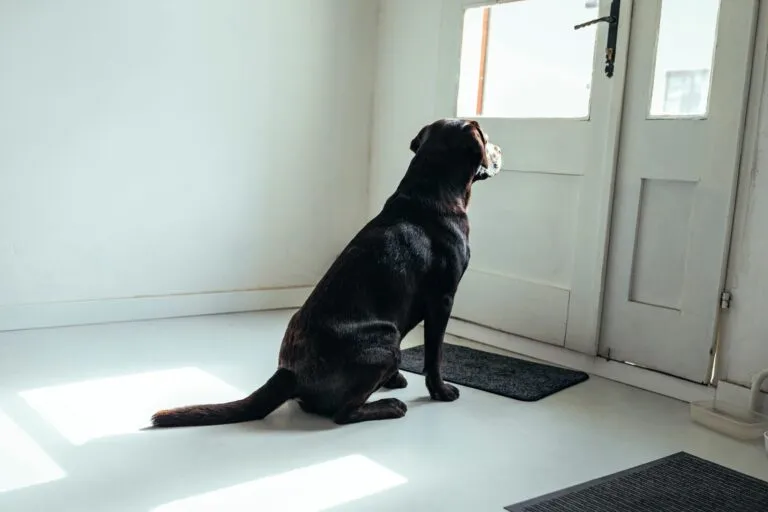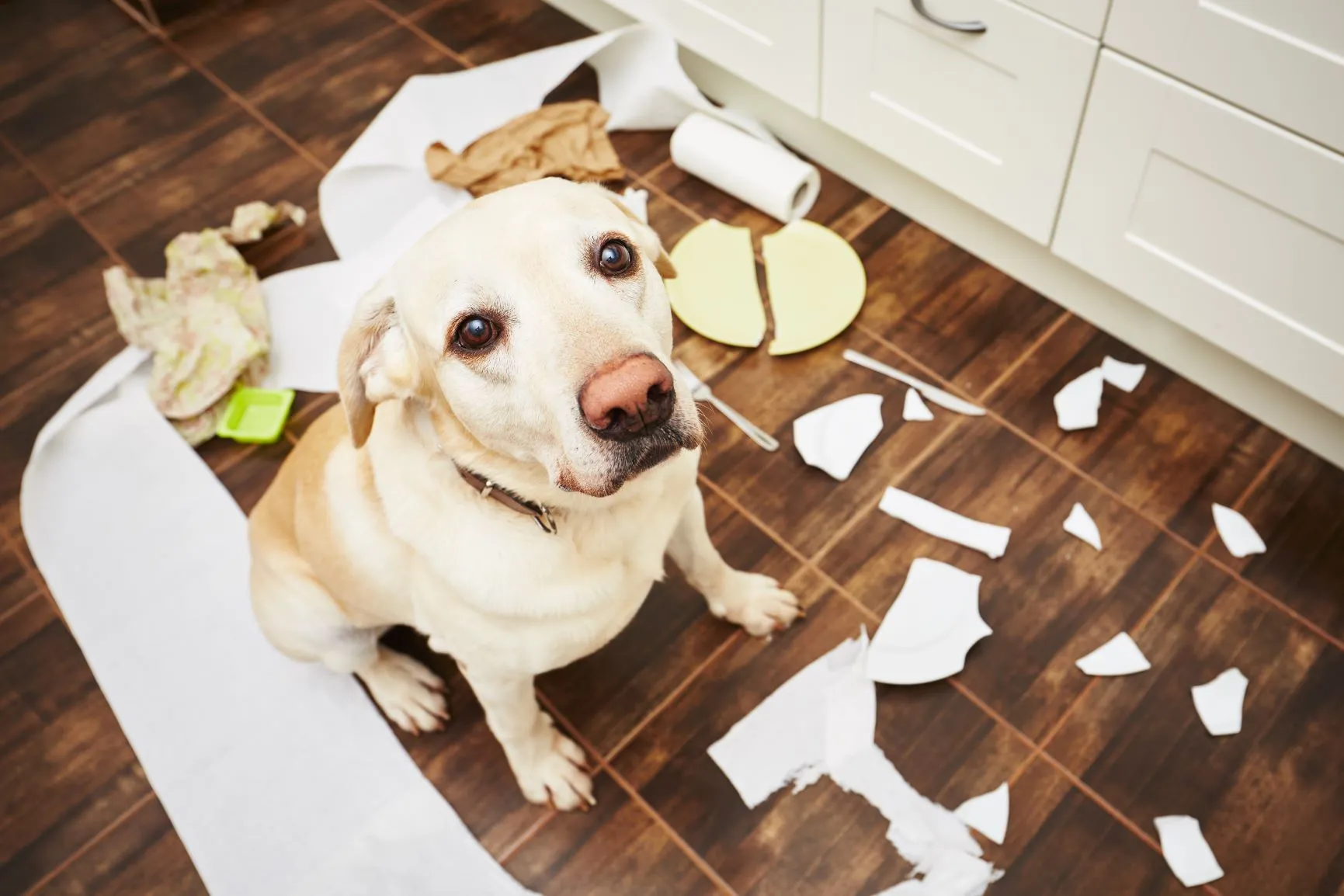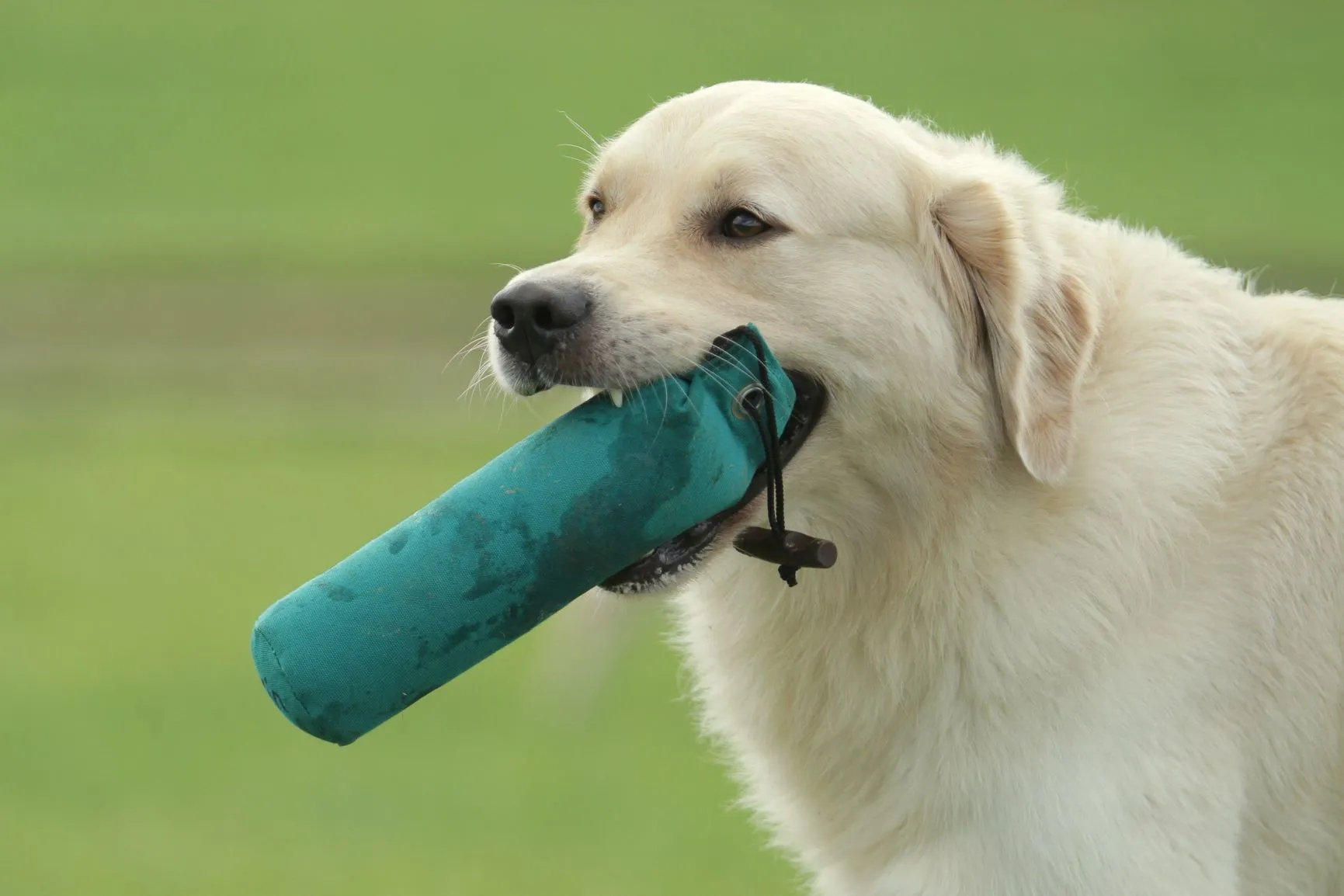Development of Puppies: From Birth to Adulthood
Every puppy goes through several developmental phases until it eventually grows into an adult dog. Learn more what is crucial for the development of puppies into self-assured and serene dogs.
Dogs are pack animals and being alone is not in their nature. But don't worry, as dogs can learn to stay alone. We have summarised how this works and the best time for training dogs to stay by themselves.

© bernardbodo / stock.adobe.com
Just buying something, a doctor’s appointment or visiting a friend with a dog hair allergy. These are situations where your dog cannot accompany you – regardless of how well trained it is. It is therefore important for your dog to learn to stay alone.
Dogs descend from wolves, which are well-known pack animals. Wolves work together, be it with hunting or rearing their young. No animal is left alone – only sick and weak animals that can no longer aid the pack are left behind.
Our dogs still maintain this instinct, whether more or less deep-seated. So it isn’t surprising that dogs don’t like to be left alone.
Anxiety of being left alone isn’t equally pronounced with all dogs. There isn’t a generic answer either regarding the source of anxiety. Dogs are individuals and just like humans, they are formed differently and have different experiences and character traits.
Nevertheless, canine anxiety of being left alone can generally be traced back to one of the following two main causes:
Dogs suffering from separation anxiety are actually scared of being alone. They feel helpless and abandoned without their owner.
In contrast, the concern with dogs with a loss of control is that their owner cannot cope without them. They feel that they have to protect and watch out for them. If their owner sets off without them, they cannot perform this task and feel worried or annoyed about it.
The training described below primarily focuses on overcoming a dog’s separation anxiety. However, if your dog is suffering from a loss of control, it’s recommended to start somewhere different. In this case, your dog first has to learn that you rule the roost in its pack.
If your dog is suffering from a loss of control, professional help is often needed. Professional dog trainers or psychologists help you to recognise and overcome the sources of a loss of control.
The causes of fear of staying alone in dogs are just as different as the way they manifest themselves.
Whilst some dogs bark loudly and howl, run restlessly or even destroy furniture, other dogs suffer in silence. They withdraw, don’t eat, sleep and at most whimper gently.
Recognising your dog’s body language and vocalisations is very helpful with treatment to overcome separation anxiety. Some experts advise setting up a pet camera with video function and observing how your dog behaves when left alone.
The video can provide helpful and useful information. Such as where the causes of its fear of being alone lie and how deep-set this is.
 © Chalabala / stock.adobe.com
© Chalabala / stock.adobe.com
Dogs suffering from separation anxiety are under huge stress. Simply never leaving them alone isn’t a solution, especially since is almost impossible in our day-to-day life. Calling the dog-sitter every time you have to nip to the supermarket? That just isn’t practical.
Hence, for humans and dogs to live together in harmony, that dogs understand that they cannot follow their owners everywhere. The calmer your dog reacts towards your absence, the more relaxed you can be about your commitments too.
Regardless of how calm your dog behaves, leaving it alone for a whole day whilst you work is too long. Dogs need a social environment in order to feel at ease.
Unfortunately, however, this knowledge doesn’t tell you how long it is acceptable to leave your dog alone for. Dogs are unique individuals and there is no standard answer to how long they can stay on their own.
Whilst some dogs already start barking when their owner reaches for their car keys, others only become restless after being alone for a few hours. However, the limit for all days is after four to five hours at the latest, because they have to go outside to relieve themselves.
Regardless of how calmly your dog behaves, the fundamental rule is that it shouldn’t always be left alone for several hours every day. Very anxious and sensitive dogs can even fall ill or develop depression if they are left alone too often. A dog-sitter or dog-sharing arrangement can help in this case.
Nevertheless, your dog shouldn’t be overcome with grief just because you aren’t there. Even people who work from home have appointments and commitments to which they cannot take their dog. It’s important for your dog not be stressed at these times.
 © Emilia007 / stock.adobe.com
© Emilia007 / stock.adobe.com
The saying ‘practice makes perfect’ is certainly true regarding your dog learning to stay alone. If dogs learn as early as the puppy phase that it is absolutely normal for their owner to go out for a short time without them, this will remain self-explanatory to them even as adults.
Read our article on Leaving puppies alone
The good news is that even adult dogs can learn to stay on their own. The bad news is that training generally lasts much longer. But your patience will pay off and even at an advanced age, your dog will still be grateful to you if it can stay on its own without any stress.
The best condition in which to teach your dog something new is when it is physically and mentally stimulated. If your dog is insufficiently challenged and bored, it isn’t receptive and will barely be able to follow your training.
Before starting with the following exercises, you should make sure that your dog is stimulated and satisfied. This works best when you spend a lot of time with and play with your dog beforehand. Take it for a walk, do search and retrieval games and ensure that your dog has worn itself out enough.
Before you actually leave the house, first start training within the four walls of your home.
If your dog is occupied with a chew bone, dog toy and seems relaxed, leave the room for a brief moment. Shut the door, go into another room and come back after a few minutes.
Ideally your dog won’t even notice you disappearing at the start. After repeating this several times, you can start to slowly increase the length of time you stay away – but not continually. Stay away for 10 minutes, then five and then 15.
This way your dog will get used to the timeframe of your disappearance being flexible. So it knows that it doesn’t have to get restless after a certain amount of time.
It’s important for you to only come back into the room if your dog is behaving calmly. If your enter the room just when your dog starts barking loudly for you, it will learn that how it behaved is the right method to call you back.
Note: Does your dog not give you a second’s peace? Then of course the only thing that helps is to come back at some point. But instead of calming your dog with your words, gestures and hands, you should fully ignore and only pay it attention again when it has calmed down.
In order for training to be a success, it’s crucial that you don’t make a big drama out of you leaving. It would be absolutely counterproductive to stroke your dog for a long time and say goodbye several times before actually closing the door behind you.
Dogs are smart and would immediately notice that there is something strange here. As well, your nerves can be transmitted to your dog.
When coming back into the room, you shouldn’t greet and pat your dog exuberantly. Even if it’s difficult, don’t pay your dog much attention and always stay calm and relaxed. This is the best way to communicate to your dog that it’s the most normal thing in the world for you to leave it on its own.
We humans frequently perform the same actions just before we leave the house. We put our shoes, scarf and jacket on, put our phone in our handbag or backpack and reach for our door keys. For dogs suffering from separation anxiety, these actions often become key stimuli and they begin to howl before you have even left the house.
The more varied you make your momentary disappearances in training, the less your dog becomes set on a certain mode of behaviour. Once your pet has learnt to stay by itself, you can of course calmly start again with your usual behaviour regarding shoes, handbag and keys.
You should be flexible until then. Sometimes go out wearing jogging pants and trainers, other times with a dress or suit and sometimes wearing socks or elegant shoes, then only a handbag or keys.
Can you leave your dog alone in a room in your home and shut the door behind you without it getting nervous? Great! Then you can leave the house for the first time.
Just like training within your home, you shouldn’t do this for the first time when you actually have an appointment. Instead, at first just go out briefly to the letterbox, garage or water the flowers in the front garden.
Again, don’t make a fuss about leaving and coming back and gradually increase the length of your absence – without becoming too predictable.
Depending on the age of your dog and how strong its anxiety of being alone is, you may have to calculate several weeks for the training described above.
Sometimes the first signs of success can be seen after two weeks, whilst other times it takes six to eight weeks for an improvement. In principle young dogs learn quicker than adult dogs, but even adult dogs are capable of learning!
If you don’t observe any progress after two to three months despite regular practice, it can be helpful to take expert advice. Vets, animal psychologists and dog trainers are good points of contact.
Perhaps there is more behind this fear of being alone than you think? Sometimes traumatic past experiences can lead to separation anxiety, which you can only overcome with professional help.
Whether it is a stubborn case, every dog (regardless of age) can learn to stay alone with the right training and plenty of patience. Don’t give up hope and practise slowly and cautiously – even if your dog struggles with being alone at first.
Naturally you cannot overdo it with training by focusing too much on quick success. If you notice that your dog is overwhelmed, it’s best to take one or two steps back in training. You will see that in the end your patience will pay off!
Every puppy goes through several developmental phases until it eventually grows into an adult dog. Learn more what is crucial for the development of puppies into self-assured and serene dogs.
Some dog lovers are sure that their canine companion understands them perfectly. Nevertheless, there are often misunderstandings between humans and dogs in day-to-day life, because what appears self-explanatory to us isn't always so clear for dogs. What do dogs really understand?
Many dog owners kiss their dogs and cats, so we can only hope that they have brushed their own teeth and their pet's too! But joking aside – cuddling and snuggling with animals isn't just unhygienic in certain cases, but can also be dangerous.